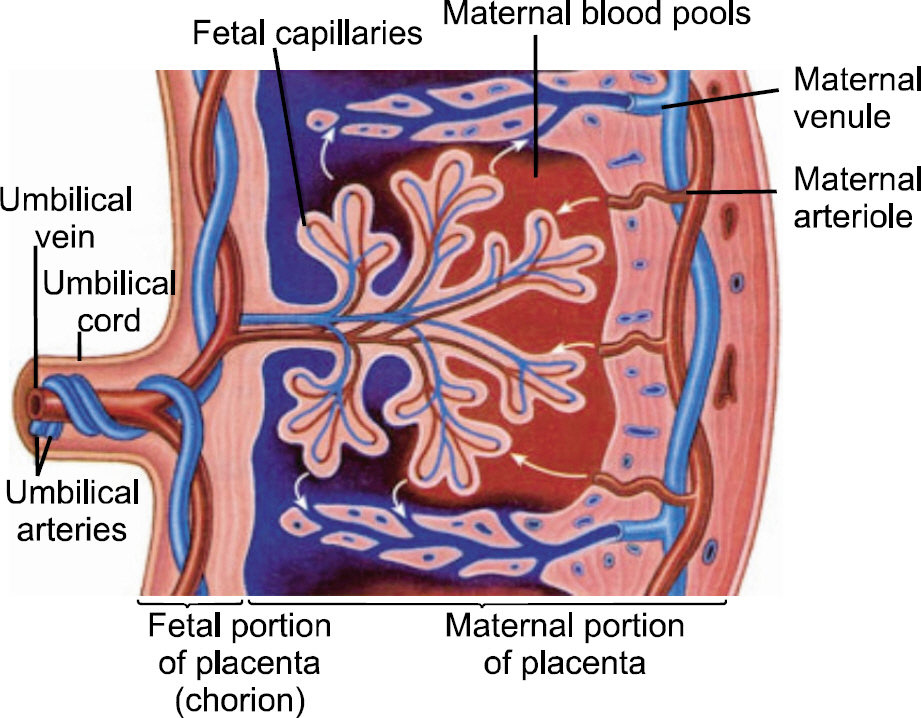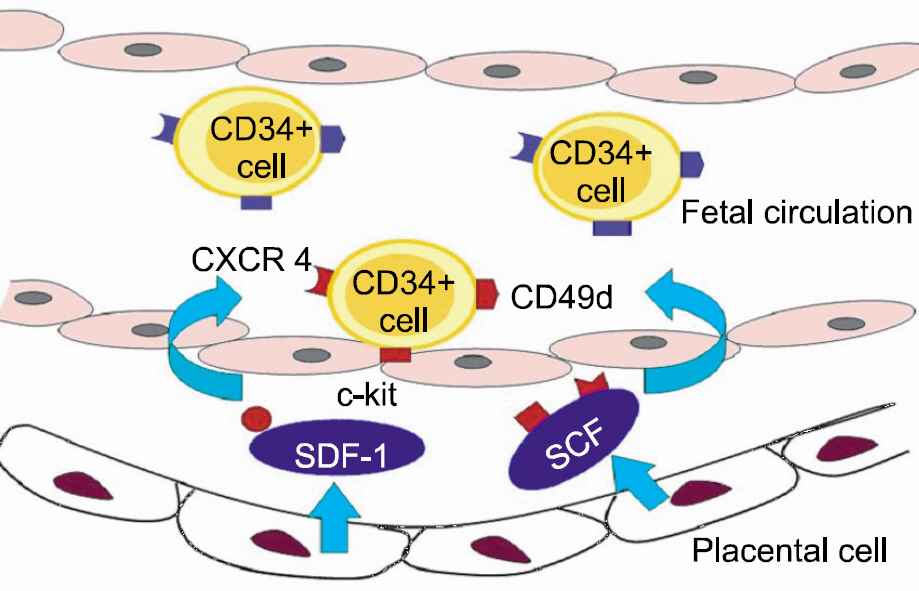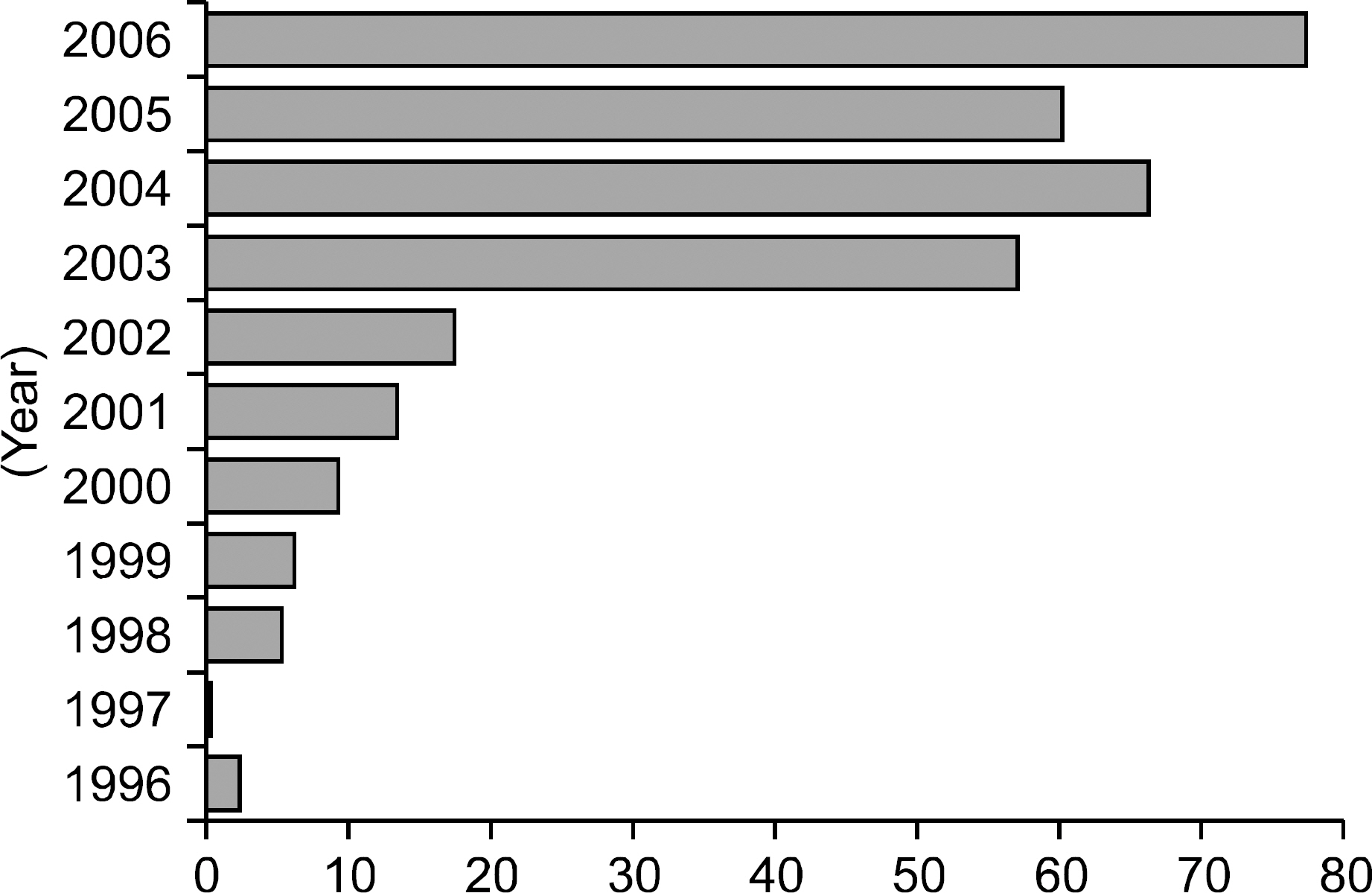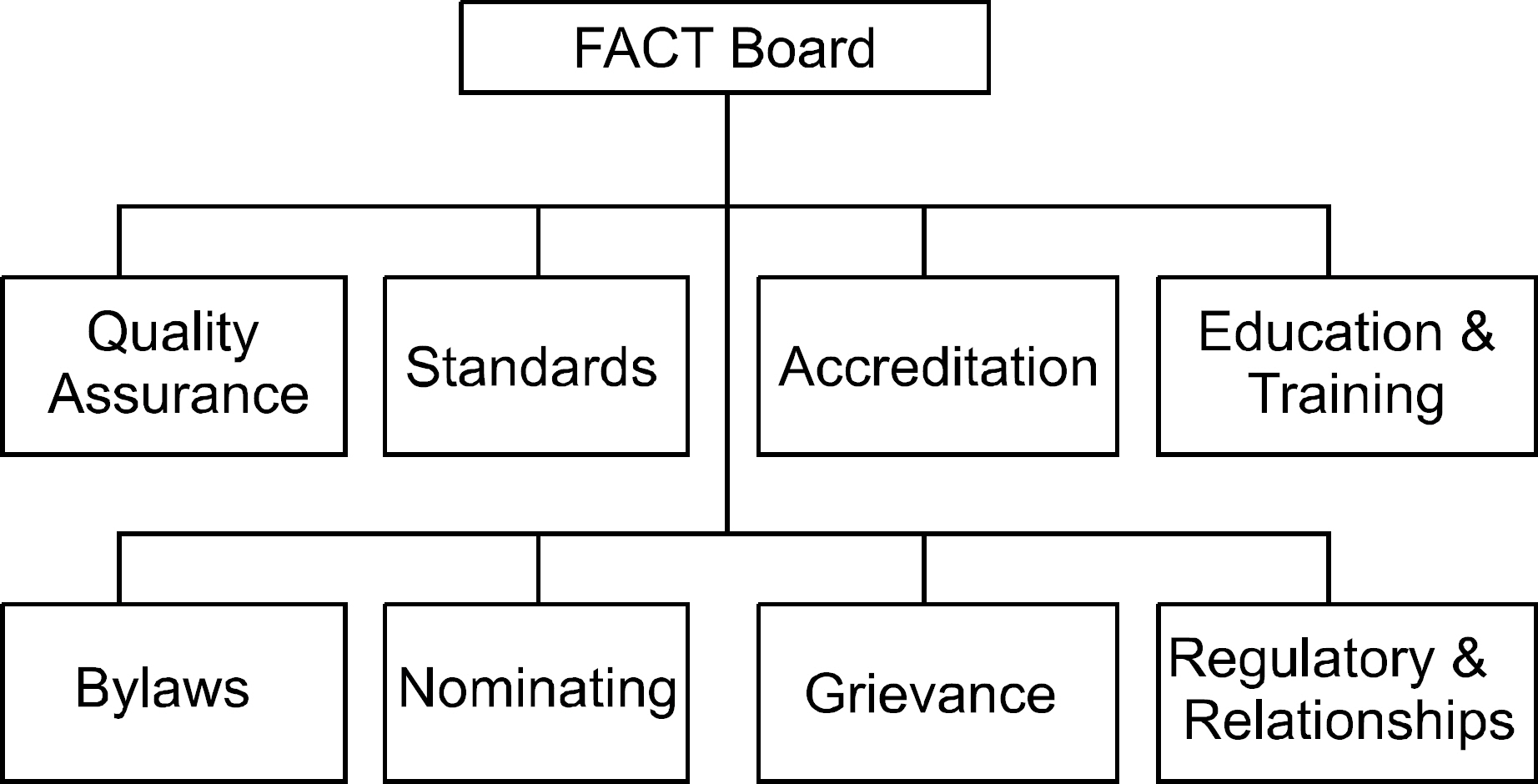Korean J Hematol.
2007 Sep;42(3):181-196. 10.5045/kjh.2007.42.3.181.
Cord Blood-Current Status and Perspective
- Affiliations
-
- 1Department of Pediatrics, Hanyang University College of Medicine, Seoul, Korea. cord@hanyang.ac.kr
- KMID: 2305193
- DOI: http://doi.org/10.5045/kjh.2007.42.3.181
Abstract
- Umbilical cord blood (CB) is increasingly used as a source of stem cells to repopulate bone marrow in the treatment of life-threatening diseases in children and adults. I review the relationship between the placenta and circulating CB stem cells for hematopoiesis, the clinical results of cord blood stem cell transplantation, and I particularly emphasizethe criteria of CB donor choice. The scientific progress for the use of CB has resulted in the organization of CB banks all over the world. I also review the status of CB banks and networking systems worldwide as recipients of government-based political support.
Keyword
MeSH Terms
Figure
Reference
-
1). Knudtzon S. In vitro growth of granulocytic colonies from circulating cells in human cord blood. Blood. 1974. 43:357–61.
Article2). Gluckman E., Broxmeyer HA., Auerbach AD, et al. Hematopoetic reconstitution in a patient with Fan-coni's anemia by means?of umbilical cord blood from an HLA-identical sibling. N Engl J Med. 1989. 321:1174–8.3). Blackburn S. Placental, fetal, and transitional circulation revisited. J Perinat Neonatal Nurs. 2006. 20:290–4.
Article4). Caprioli A., Jaffredo T., Gautier R., Dubourg C., Dieterlen-Lièvre F. Blood-borne seeding by hematopoietic endothelial precursors from the allantois. Proc Natl Acad Sci USA. 1998. 95:1641–6.5). Caprioli A., Minko K., Drevon C., Eichmann A., Dieterlen-Lièvre F., Jaffredo T. Hemangioblast commitment in the avian allantois: cellular and molecular aspects. Dev Biol. 2001. 238:64–78.
Article6). Keelan JA., Marvin KW., Sato TA., Coleman M., McCowan LM., Mitchell MD. Cytokine abundance in placental tissues: evidence of inflammatory activation in gestational membranes with term and preterm parturition. Am J Obstet Gynecol. 1999. 181:1530–6.
Article7). Kauma S., Huff T., Krystal G., Ryan J., Takacs P., Turner T. The expression of stem cell factor and its receptor, c-kit in human endometrium and placental tissues during pregnancy. J Clin Endocrinol Metab. 1996. 81:1261–6.
Article8). Kovach NL., Lin N., Yednock T., Harlan JM., Broudy VC. Stem cell factor modulates avidity of alpha 4 beta 1 and alpha 5 beta 1 integrins expressed on hematopoietic cell lines. Blood. 1995. 85:159–67.
Article9). Lévesque JP., Leavesley DI., Niutta S., Vadas M., Simmons PJ. Cytokines increase human hemopoietic cell adhesiveness by activation of very late antigen (VLA)-4 and VLA-5 integrins. J Exp Med. 1995. 181:1805–15.
Article10). Lévesque JP., Haylock DN., Simmons PJ. Cytokine regulations of proliferation and cell adhesion are correlated events in human CD34+ hemopoietic progenitors. Blood. 1996. 88:1168–76.11). Coulomb-L'Hermine A., Emilie D., Durand-Gasselin I., Galanaud P., Chaouat G. SDF-1 production by placental cells: a potent mechanism of inhibition of mother-to-fetus HIV transmission. AIDS Res Hum Retroviruses. 2000. 16:1097–8.12). Aiuti A., Webb IJ., Bleul C., Springer T., Gutierrez-Ramos JC. The chemokine SDF-1 is a chemoattractant for human CD34+ hematopoietic progenitor cells and provides a new mechanism to explain the mobilization of CD34+ progenitors to peripheral blood. J Exp Med. 1997. 185:111–20.
Article13). Kim JP., Lee YH., Lee YA., Kim YD. A comparison of the kinetics of nucleated cells and CD34+ cells in neonatal peripheral blood and cord blood. Biol Blood Marrow Transplant. 2007. 13:478–85.
Article14). Sutherland DR., Keating A., Nayar R., Anania S., Stewart AK. Sensitive detection and enumeration of CD34+ cells in peripheral and cord blood by flow cytometry. Exp Hematol. 1994. 22:1003–10.15). Wu AG., Michejda M., Mazumder A, et al. Analysis and characterization of hematopoietic progenitor cells from fetal bone marrow, adult bone marrow, peripheral blood, and cord blood. Pediatr Res. 1999. 46:163–9.
Article16). Thilaganathan B., Nicolaides KH., Morgan G. Subpopulations of CD34-positive haemopoietic progenitors in fetal blood. Br J Haematol. 1994. 22:634–6.
Article17). Fritsch G., Stimpfl M., Kurz M, et al. The composition of CD34 subpopulations differs between bone marrow, blood and cord blood. Bone Marrow Transplant. 1996. 17:169–78.18). Hows JM., Bradley BA., Marsh JC, et al. Growth of human umbilical-cord blood in long term haemopoietic cultures. Lancet. 1992. 340:73–6.19). Sutherland HJ., Eaves CJ., Eaves AC., Dragowska W., Lansdorp PM. Characterization and partial purification of human marrow cells capable of initiating long-term hematopoiesis in vitro. Blood. 1989. 74:1563–70.
Article20). Verfaillie C., Blakolmer K., McGlave P. Purified primitive human hematopoietic progenitor cells with long-term in vitro repopulating capacity adhere selectively to irradiated bone marrow stroma. J Exp Med. 1990. 172:509–2.
Article21). Lee YH., Bae KL., Park SS, et al. CD34+HLA-DR+ cells in cord blood have better correlations than CD34+ cells with CFU-GM. Cancer Res Ther Control. 1999. 7:267–71.22). Mayani H., Lansdorp PM. Thy-1 expression is linked to functional properties of primitive hematopoietic progenitor cells from human umbilical cord blood. Blood. 1994. 83:2410–7.
Article23). Steen R., Tjønnfjord GE., Egeland T. Comparison of the phenotype and clonogenicity of normal CD34+ cells from umbilical cord blood, granulocyte colony-stimulating factor-mobilized peripheral blood, and adult human bone marrow. J Hematother. 1994. 93:253–62.24). Pettengell R., Luft T., Henschler R, et al. Direct comparison by limiting dilution analysis of long-term culture initiating cells in human bone marrow, umbilical cord blood and blood stem cells. Blood. 1994. 84:3653–9.
Article25). Lee YH., Lee YA., Noh KT, et al. Homing-associated cell adhesion molecules and cell cycle status on the nucleated cells in the bone marrow, mobilized peripheral blood and cord blood. J Korean Med Sci. 2004. 19:523–8.
Article26). Harris DT., Schumacher MJ., Locascio J, et al. Phenotypic and functional immaturity of human umbilical cord blood T lymphocytes. Proc Natl Acad Sci USA. 1992. 89:10006–10.
Article27). Hannet I., Erkeller-Yuksel F., Lydyard P., Deneys V., DeBruyère M. Developmental and maturational changes in human blood lymphocyte subpopulations. Immunol Today. 1992. 13:215–8.
Article28). Clement LT., Vink PE., Bradley GE. Novel immunoregulatory functions of phenotypically?distinct subpopulations of CD4+ cells in the human neonate. J Immunol. 1990. 145:102–8.29). Deacock SJ., Schwarer AP., Brige J., Batchelor JR., Goldman JM., Lechler RI. Evidence that umblical cord blood contains a higher frequency of HLA Class II-specific alloreactive T cells than adult peripheral blood. A limiting dilution analysis. Transplantation. 1992. 53:1128–34.30). Carcia-Vela J., Delgado I., Auray MC., Alvarez S., Bornstein R., Gilsanz F. Analysis of cord blood lymphocytes. Fourth International Cord Blood Congress: Processing, Banking, Biology & Transplants. 1997. 72.31). NetCORD inventory and use on June, 2007. (Accessed September 15, 2007, at. https://www.netcord.org/inventory.html. .).32). Barker JN., Weisdorf DJ., DeFor TE, et al. Transplantation of 2 partially HLA-matched umbilical cord blood units to enhance engraftment in adults with hematologic malignancy. Blood. 2005. 105:1343–7.
Article33). Lee YH., Cho NC., Je KH, et al. Successful sibling cord blood stem cell transplantation for relapsed acute mixed lineage leukemia. Korean J Hematol. 1999. 34:471–6.34). Kim KS. Report from Nursing Group of The Korean Society of Blood and Marrow Transplantation. 2007.35). Koo HH., Yoo KH., Sung KW, et al. Double unit cord blood transplantation in Korean children. The Proceedings of the 11th Congress of Asia Pacific Bone Marrow Transplantation. 2006. 64.36). Kurtzberg J., Laughlin M., Graham ML, et al. Placental blood as a source of hematopoietic stem cells for transplantation into unrelated recipients. N Engl J Med. 1996. 335:157–66.
Article37). Wagner JE., Rosenthal J., Sweetman R, et al. Successful transplantation of HLA-matched and HLA-mismatched umbilical cord blood from unrelated donors: analysis of engraftment and acute graft-versus-host disease. Blood. 1996. 88:795–802.
Article38). Wagner JE., Kernan NA., Steinbuch M., Broxmeyer HE., Gluckman E. Allogeneic sibling umbilical cord blood transplantation in children with malignant and nonmalignant disease. Lancet. 1995. 346:214–9.39). Michel G., Rocha V., Chevret S, et al. Unrelated cord blood transplantation for childhood acute myeloid leukemia: a Eurocord Group analysis. Blood. 2003. 102:4290–7.
Article40). Wagner JE., Barker JN., DeFor TE, et al. Transplantation of unrelated donor umbilical cord blood in 102 patients with malignant and nonmalignant diseases: influence of CD34 cell dose and HLA disparity on treatment-related mortality and survival. Blood. 2002. 100:1611–8.
Article41). Gluckman E., Rocha V., Boyer-Chammard A, et al. Outcome of cord-blood transplantation from related and unrelated donors. Eurocord Transplant Group and the European Blood and Marrow Transplantation Group. N Engl J Med. 1997. 337:373–81.42). Rocha V., Cornish J., Sievers EL, et al. Comparison of outcomes of unrelated bone marrow and umbilical cord blood transplants in children with acute leukemia. Blood. 2001. 97:2962–71.
Article43). Barker JN., Davies SM., DeFor T, et al. Survival after transplantation of unrelated donor umbilical cord blood is comparable to that of human leukocyte antigen-matched unrelated donor bone marrow: results of a matched-pair analysis. Blood. 2001. 97:2957–61.
Article44). Locatelli F., Rocha V., Chastang C, et al. Factors associated with outcome after cord blood transplantation in children with acute leukemia. Euro-cord-Cord Blood Transplant Group. Blood. 1999. 93:3662–71.45). Locatelli F., Rocha V., Reed W, et al. Related umbilical cord blood transplantation in patients with thalassemia and sickle cell disease. Blood. 2003. 101:2137–43.
Article46). Koo HH., Yoo KH., Sung KW, et al. Clinical results of cord blood transplantation in Korea. The Proceedings of the 3rd Annual Meeting of Asian Hematology Association. 2005. 46.47). Barker JN., Hough RE., van Burik JA, et al. Serious infections after unrelated donor transplantation in 136 children: impact of stem cell source. Biol Blood Marrow Transplant. 2005. 11:362–70.
Article48). Rocha V., Cornish J., Sievers EL, et al. Comparison of outcomes of unrelated bone marrow and umbilical cord blood transplants in children with acute leukemia. Blood. 2001. 97:2962–71.
Article49). Lim YJ., Lee YH., Koo HH, et al. Korean experience of infectious complications following cord blood stem cell transplantation in children. ASH annual abstracts 2007 (in press).50). Rocha V., Wagner JE Jr., Sobocinski KA, et al. Graft-versus-host disease in children who have received a cord blood or bone marrow transplant from an HLA-identical sibling. Eurocord and International Bone Marrow Transplant Registry Working Committee on Alternative Donor and Stem Cell Sources. N Engl J Med. 2000. 342:1846–54.51). Hwang WY., Samuel M., Tan D., Koh LP., Lim W., Linn YC. A meta-analysis of unrelated donor umbilical cord blood transplantation versus unrelated donor bone marrow transplantation in adult and pediatric patients. Biol Blood Marrow Transplant. 2007. 13:444–53.
Article52). Madrigal JA., Cohen SB., Gluckman E., Charron DJ. Does cord blood transplantation result in lower graft-versus-host disease? It takes more than two to tango. Hum Immunol. 1997. 56:1–5.53). Jacobsohn DA., Hewlett B., Ranalli M., Seshadri R., Duerst R., Kletzel M. Outcomes of unrelated cord blood transplants and allogeneic-related hematopoietic stem cell transplants in children with high-risk acute lymphocytic leukemia. Bone Marrow Transplant. 2004. 34:901–7.
Article54). Rocha V., Arcese W., Sanz G, et al. Prognostic factors of outcome after unrelated cord blood transplant (UCBT) in adults with hematologic malignancies. Blood. 2000. 96(Abstr):587a.55). Rocha V., Labopin M., Sanz G, et al. Transplants of umbilical-cord blood or bone marrow from unrelated donors in adults with acute leukemia. N Engl J Med. 2004. 351:2276–85.
Article56). Laughlin MJ., Eapen M., Rubinstein P, et al. Outcomes after transplantation of cord blood or bone marrow from unrelated donors in adults with leukemia. N Engl J Med. 2004. 351:2265–75.
Article57). Laughlin MJ., Barker J., Bambach B, et al. Hematopoietic engraftment and survival in adult recipients of umbilical-cord blood from unrelated donors. N Engl J Med. 2001. 344:1815–22.
Article58). Sanz GF., Saavedra S., Planelles D, et al. Standardized, unrelated donor cord blood transplantation in adults with hematologic malignancies. Blood. 2001. 98:2332–8.
Article59). Takahashi S., Iseki T., Ooi J, et al. Single-institute comparative analysis of unrelated bone marrow transplantation and cord blood transplantation for adult patients with hematological malignancies. Blood. 2004. 104:3813–20.60). Cornetta K., Laughlin M., Carter S, et al. Umbilical cord blood transplantation in adults: results of the prospective Cord Blood Transplantation (COBLT). Biol Blood Marrow Transplant. 2005. 11:149–60.
Article61). Ooi J., Iseki T., Takahashi S, et al. Unrelated cord blood transplantation for adult patients with de novo acute myeloid leukemia. Blood. 2004. 103:489–91.
Article62). Long GD., Laughlin M., Madan B, et al. Unrelated umbilical cord blood transplantation in adult patients. Biol Blood Marrow Transplant. 2003. 9:772–80.
Article63). Parody R., Martino R., Rovira M, et al. Severe infections after unrelated donor allogeneic hematopoietic stem cell transplantation with peripheral blood and bone marrow transplantation. Biol Blood Marrow Transplant. 2006. 12:734–48.64). Kai S., Misawa M., Iseki T, et al. Double-unit cord transplantation in Japan. ASH Annual meeting abstracts. 2004. 104(Abstr):5166a.65). Barker JN., Weisdorf DJ., Wagner JE. Creation of a double chimera after transplantation of umbilical-cord blood from two partially matched unrelated donors. N Engl J Med. 2001. 344:1870–1.66). Brunstein CG., Barker J., DeFor T., French K., Weisdorf DJ., Wagner JE. Non-myeloablative umbilical cord blood transplantation: promising disease-free survival in 95 consecutive patients. ASH Annual meeting abstracts. 2005. 106(Abstr):559a.67). Barker JN., Weisdorf DJ., DeFor TE., Blazar BR., Miller JS., Wagner JE. Rapid and complete donor chimerism in adult recipients of unrelated donor umbilical cord blood transplantation after reduced-intensity conditioning. Blood. 2003. 102:1915–9.
Article68). Majhail NS., Weisdorf DJ., Wagner JE., Defor TE., Brunstein CG., Burns LJ. Comparable results of umbilical cord blood and HLA-matched sibling donor hematopoietic stem cell transplantation after reduced-intensity preparative regimen for advanced Hodgkin lymphoma. Blood. 2006. 107:3804–7.
Article69). Verneris MR., Brunstein CG., DeFor T, et al. Risk of relapse after umbilical cord blood transplantation in patients with acute leukemia: marked reduction in recipients of two units. ASH Annual meeting abstracts. 2005. 106(Abstr):305a.70). Ballen KK., Spitzer TR., Yeap B, et al. Excellent disease free survival after double cord blood transplantation using a reduced intensity chemotherapy only conditioning regimen in a diverse adult population. ASH Annual meeting abstracts. 2005. 106(Abstr):2048a.71). Barker JN., Weisdorf DJ., DeFor TE., Brunstein CG., Wagner JE. Umbilical cord blood (UCB) transplantation after non-myeloablative (NMA) conditioning for advanced follicular leukemia: low transplant-related mortality and high progression- free survival. ASH Annual meeting abstracts. 2005. 106(Abstr):2900a.72). Majhail NS., Brunstein CG., Wagner JE. Double umbilical cord blood transplantation. Curr Opinion Immunol. 2006. 18:571–5.
Article73). Kollman C., Howe CW., Anasetti C, et al. Donor characteristics as risk factors in recipients after transplantation of bone marrow from unrelated donors: the effect of donor age. Blood. 2001. 98:2043–51.
Article74). Hurley CK., Wagner JE., Setterholm MI., Confer DL. Advances in HLA: practical implications for selecting adult donors and cord blood units. Biol Blood Marrow Transplant. 2006. 12(S1):28–33.
Article75). Wall DA., Carter SL., Kernan NA, et al. Busulfan/melphalan/antithymocyte globulin followed by unrelated donor cord blood transplantation for treatment of infant leukemia and leukemia in young children: the cord blood transplantation study (COLBT) experience. Biol Blood Marrow Transplant. 2005. 11:637–46.76). Gluckman E., Rocha V. Donor selection for unrelated cord blood transplants. Curr Opinion Immunol. 2006. 18:565–70.
Article77). de Lima M., Patah PA., Saliba R, et al. Donor-recipient host-versus-graft human leukocyte antigen mismatches and outcome of cord blood transplants. The Proceedings of the 5th Annual International Umbilical Cord Blood Transplantation Symposium. 2007.78). Eapen M., Rubinstein P., Zhang MJ, et al. Outcomes of transplantation of unrelated donor umbilical cord blood and bone marrow in children with acute leukaemia: a comparison study. Lancet. 2007. 369:1947–54.
Article79). Shim JS., Cho B., Kim M, et al. Early apoptosis in CD34+ cells as a potential heterogeneity in quality of cryopreserved umbilical cord blood. Br J Haematol. 2006. 135:210–3.80). Rocha V. Gluckman E on behalf of the Eurocord-Netcord registry. Analysis of risk factors affecting survival after UCBT in children and adults with haematological malignancy. The Proceedings of the 5th Annual International Umbilical Cord Blood Transplantation Symposium. 2007.81). Briddell RA., Kern BP., Zilm KL., Stoney GB., McNiece IK. Purification of CD34+ cells is essential for optimal ex vivo expansion of umbilical cord blood cells. J Hematother. 1997. 6:145–50.
Article82). Piacibello W., Sanavio F., Garetto L, et al. Differential growth factor requirement of primitive cord blood hematopoietic stem cell for self-renewal and amplification vs proliferation and differentiation. Leukemia. 1998. 12:718–27.
Article83). Rice AM., Wood JA., Milross CG, et al. Prior cryopreservation of ex vivo expanded cord blood cells is not detrimental to engraftment as measured in the NOD-SCID mouse model. J Hematother Stem Cell Res. 2001. 10:157–65.84). Lazzari L., Lucchi S., Montemurro T, et al. Evaluation of the effect of cryopreservation on ex vivo expansion of hematopoietic progenitors from cord blood. Bone Marrow Transplant. 2001. 28:693–8.
Article85). McNiece I., Shapall E. Ex vivo expansion of hematopoietic progenitor cells from cord blood-clinical experience. Third International Indianapolis Con-ference/Workshop. 2001.86). Lee YH., Han JY., Seo SY, et al. Stem cell expressing homing receptors could be expanded from cryopreserved and unselected cord blood. J Korean Med Sci. 2004. 19:635–9.87). Park SK., Won JH., Kim HJ, et al. Co-transplantation of human mesenchymal stem cells promotes human CD34+ cells engraftment in a dose-dependent fashion in NOD/SCID mice. J Korean Med Sci. 2007. 22:412–9.
Article88). Le Blanc K., Samuelsson H., Gustafsson B, et al. Transplantation of mesenchymal stem cells to enhance engraftment of hematopoietic stem cells. Leukemia. 2007. 21:1733–8.
Article89). Castello S., Podestà M., Menditto VG, et al. Intra-bone marrow injection of bone marrow and cord blood cells: an alternative way of transplantation associated with a higher seeding efficiency. Exp Hematol. 2004. 32:782–7.
Article90). El-Badri NS., Wang BY., Cherry ., Good RA. Oste-oblasts promote engraftment of allogeneic hematopoietic stem cells. Exp Hematol. 1998. 26:110–6.91). Calvi LM., Adams GB., Weibrecht KW, et al. Osteoblastic cells regulate the hematopoietic stem cell niche. Nature. 2003. 425:841–6.92). Calvi LM., Sims NA., Hunzelman JL, et al. Activated parathyroid hormone/parathyroid hormone-related protein receptor in osteoblastic cells differentially affects cortical and trabecular bone. J Clin Invest. 2001. 107:277?86.?.
Article93). Wong A., Yuen PM., Li K., Yu AL., Tsoi WC. Cord blood collection before and after placental delivery: levels of nucleated cells, haematopoietic progenitor cells, leukocyte subpopulations and macroscopic clots. Bone Marrow Transplant. 2001. 27:133–8.
Article94). Pafumi C., Farina M., Bandiera S, et al. Differences in umbilical cord blood units collected during cesarean section, before or after the delivery of the placenta. Gynecol Obstet Invest. 2002. 54:73–7.
Article95). Harris DT., Schumacher MJ., Rychlik S, et al. Collection, seperation and cryopreservation of umbilical cord blood for use in transplantation. Bone Marrow Transplant. 1994. 13:135–43.96). Zingsem J., Strasser E., Weisbach V, et al. Cord blood processing with an automated and functionally closed system. Transfusion. 2003. 43:806–13.
Article97). Berz D., McCormack EM., Winer ES., Colvin GA., Quesenberry PJ. Cryopreservation of hematopoietic stem cells. Am J Hematol. 2007. 82:463–72.
Article98). Steinbrook R. The cord-blood-bank controversies. N Engl J Med. 2004. 351:2255–7.
Article99). Lee YH. Establishment of development and managing system for public cord blood bank. Report for The Ministry of Health and Welfare. 2006.100). Mayor S. World's first public-private cord blood bank launched in UK. BMJ. 2007. 334:277.
Article101). Warkentin PI. Accreditation process and cord blood bank standards. FACT cord blood bank inspection and accreditation workshop. 2007.102). Lee YH., Kim HS., Lee KS, et al. Standardization of cord blood separation method for establishment of Korean cord blood bank. Korean J Hematol. 1999. 34:235–40.103). Lee YH., Bae KL., Park SS, et al. The effect of time interval and temperature between cord blood collection and processing on mononuclear cells and CD34+ cells. Korean J Hematopoietic Stem Cell Transplant. 1997. 1:47–53.104). Lee YH., Park HW., Han H., Han JY., Kim JS., Kim HJ. An optimal condition for red cell depletion of cord blood with pentastarch. Korean J Pediatr Hematol-Oncol. 1999. 6:124–30.105). Lee KS. Long-term cryopreservation of hematopoietic stem cells by deep freezing method for umbilical cord blood stem cell transplantation. Korean J Pediatr Hematol-Oncol. 1997. 4:167–80.106). Choi YM. Umbilical cord blood stem cell transplantation. J Korean Med Assoc. 1998. 41:849–54.107). Meyer EA., Hanna K., Gebbie K. Cord blood-establishing a national hematopoietic stem cell bank program. WA: Institute of Medicine, The National Academies Press. 2005. 1–314.108). Lee YH. Legal management of cord blood. Report for The Ministry of Health and Welfare. 2004.109). Lee YH., Song YM. The private plan on management of umbilical cord blood. Korean J Med Law. 2005. 13:41–62.110). Lee YH., Kook H., Koo HH, et al. The guideline and statute for cord blood banks in Korea. The proceedings of the 3rd Annual meeting of Asian Hematology Association. 2005. 51–3.





